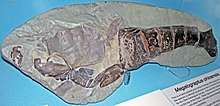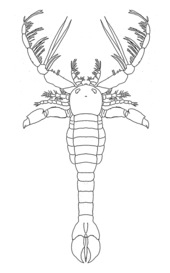Megalograptus
Megalograptus is a genus of eurypterid recovered from deposits of Ordovician age. The genus is classified as part of the Megalograptidae family and contains five species, four (M. ohioensis, M. shideleri, M. welchi and M. williamsae) from Ohio and one (M. alveolatus) from Virginia.[1]
| Megalograptus | |
|---|---|
 | |
| Replica of the M. ohioensis holotype, Orton Geology Museum | |
| Scientific classification | |
| Kingdom: | Animalia |
| Phylum: | Arthropoda |
| Subphylum: | Chelicerata |
| Order: | †Eurypterida |
| Superfamily: | †Carcinosomatoidea |
| Family: | †Megalograptidae |
| Genus: | †Megalograptus Miller, 1874 |
| Type species | |
| Megalograptus welchi Miller, 1874 | |
| Other species | |
| |
"Megalograptus" translates to "big writing" or "great graptolite" in Greek, a generic name that derives from that the first known fossils recovered of the genus were its spiny legs, which were mistaken for massive graptolites. Megalograptus was relatively large for an Ordovician predator, with the largest species (M. ohioensis) capable of reaching lengths of 78 cm (31 in).[2] Other than its large size, Megalograptus is also of interest due to being one of the oldest known eurypterids in the fossil record.[3]
Description

Megalograptus is not only noteworthy for being only one of the earliest known eurypterids, but also for being one of the most unusual genera described. Particularly interesting is its enlargened third appendage, different from all other known eurypterids in its length and the long spines directed towards its center. The exact use of these strange adaptations to the appendage is unknown, perhaps the basket-like structure of the spines would have allowed Megalograptus to rake through the sediment to find prey.[3]
Megalograptids, the family to which Megalograptus belonged, were characterized by large exoskeletons with ovate to triangular scales. The prosoma (head) was subquadrate, with a tongue-like anterior process bearing marginal spines, and compound eyes on the top front of the head. The chelicerae (claws in front of the mouth) were small and short. The first and third pairs of walking legs were short, with diverging or closely spaced spines. The second pair of walking legs was enormously developed, with long paired spines. The fourth pair of walking legs was nearly spineless. The preabdomen, the front portion of the body, was narrow with axial furrows, while the postabdomen was moderately narrow with broad, flat and curved appendages on the last body segment. The telson was short and lanceolate.[4] The unusual third appendages differentiated Megalograptus from other members of its family, such as Echinognathus.[5]
See also
- List of eurypterids
References
- Dunlop, J. A., Penney, D. & Jekel, D. 2015. A summary list of fossil spiders and their relatives. In World Spider Catalog. Natural History Museum Bern, online at http://wsc.nmbe.ch, version 16.0 http://www.wsc.nmbe.ch/resources/fossils/Fossils16.0.pdf (PDF).
- Lamsdell, James C.; Briggs, Derek E. G.; Liu, Huaibao; Witzke, Brian J.; McKay, Robert M. (September 1, 2015). "The oldest described eurypterid: a giant Middle Ordovician (Darriwilian) megalograptid from the Winneshiek Lagerstätte of Iowa". BMC Evolutionary Biology. 15: 169. doi:10.1186/s12862-015-0443-9. PMC 4556007. PMID 26324341. Retrieved September 1, 2015.
- "Megalograptus – A Predator in our Ancient Ordovician Ocean | Cincinnati Museum Center". www.cincymuseum.org. Archived from the original on 2018-01-05. Retrieved 2018-01-04.
- Størmer, L 1955. Merostomata. Treatise on Invertebrate Paleontology, Part P Arthropoda 2, Chelicerata, P36.
- Størmer, L 1955. Merostomata. Treatise on Invertebrate Paleontology, Part P Arthropoda 2, Chelicerata, P36.
